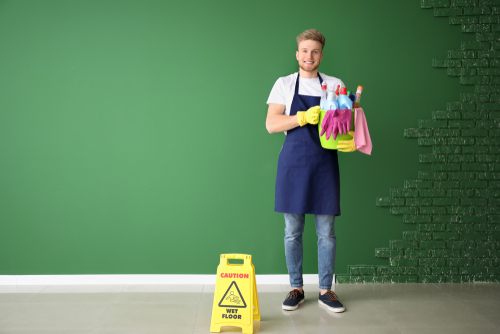Cold and cough season is officially here. As a facilities manager, it’s important to implement a rigorous cleaning plan at your building to remove dust, allergens, and infectious agents. It’s equally important to maintain well-stocked restrooms and break rooms, with soap and paper towels, to promote handwashing—one of the first lines of defense we have from illness.
While you may have a well-established cleaning routine, have you ever thought about how the chemicals present in cleaning products could negatively impact the health of building occupants or janitorial staff? Here are some of the benefits of going green with your cleaning program:
- Reduces building occupants’ and janitorial staff’s exposure to irritating chemicals. You can also protect populations that are particularly sensitive to chemicals (e.g., asthma sufferers and those with other respiratory conditions, children, and the elderly).
- Improved indoor air quality. Many green chemicals emit a lower level of volatile organic compounds (VOCs), gases that can cause eye, nose, and throat irritation; headaches; and nausea, among other symptoms.
- Green cleaning supplies are generally less toxic to the environment. For instance, they may have biodegradable formulas, have low aquatic toxicity, or come in sustainable packaging.
- The concentrated chemicals in some traditional commercial/industrial cleaning products are hazardous and may require special handling, treatment, and disposal.
What’s In, What’s Out
Green cleaning products contain surfactants that help to mechanically wipe or wash away dirt and germs. Generally, green cleaning products do not contain antimicrobial or disinfectant ingredients—this means that bacteria and viruses are not “killed” but rather removed from surfaces.
Cleaning products and personal care items containing disinfectant ingredients that make claims such as “kills 99.9% of germs” are generally regulated by the U.S. Food and Drug Administration (FDA) or the Environmental Protection Agency (EPA). It may surprise you to learn that, according to the FDA, there’s not enough evidence to show that hand soaps that contain antibacterial agents are better at preventing illness than washing hands with regular soap and water.
Some common disinfectants, antimicrobials, and antibacterial chemicals pose safety concerns. In 2017, Triclosan, an antibacterial found in many over-the-counter (OTC) soaps, body washes, and toothpastes, was banned for use “without premarket review due to insufficient data regarding their safety and effectiveness.” However, note that there may be health codes or other regulations requiring antimicrobial hand soaps in certain industries such as food service or health care.
If you want to kill germs, steam cleaning is a great option. Using only tap water, steam cleaners effectively remove dirt and grime, and the high temperatures sanitize surfaces, making disinfectant chemicals unnecessary. There are many commercial-grade steam cleaners available on the market, with prices as low as $1,000.
Purchasing Green Cleaning Products
When shopping for cleaning products, you’ve probably seen labels such as biodegradable, natural, earth-friendly, and eco-safe on product packaging. But don’t be fooled. Largely, these terms have no legal definition, which means that a manufacturer does not need to adhere to any standard or substantiate the claim. This is a common marketing tactic; companies may add these labels to mislead consumers into thinking they’re buying something less harmful to the environment when they actually aren’t.
To be certain that you are purchasing a green cleaning product, look for items that bear the seal of a third-party certification body. These products have been evaluated and confirmed that they avoid specific health and/or environmental impacts. Here are a few to look out for:
- Green Seal. The nonprofit Green Seal organization has certified many cleaning products that meet its strict standards relating to human and environmental health. You can search its database to find over 925 certified industrial and institutional cleaning and janitorial products here.
- UL ECOLOGO®. Underwriters Laboratories (UL), a global safety certification company, certifies cleaning products under its ECOLOGO program. Search the database of ECOLOGO-certified products here.
- EPA Safer Choice. The EPA certifies products that meet its Safer Choice Standard. You can search the database of thousands of products and filter by product type here.
- USDA BioPreferred. The U.S. Department of Agriculture (USDA) certifies products that have an increased percentage of biologically sourced ingredients. The program “reduces our nation’s reliance on petroleum, increases the use of renewable agricultural resources, and contributes to reducing adverse environmental and health impacts.” Search the catalog here.
Green Cleaning in LEED
Looking to earn some Leadership in Energy and Environmental Design (LEED) points at your building? There are multiple ways to achieve a point for green cleaning in the LEED v4.1 Existing Buildings Operations and Maintenance (EBOM) rating system. A Green Cleaning Policy is a prerequisite, meaning that it is mandatory for every building to achieve a LEED certification of any level. A Green Cleaning Policy requires working with a cleaning service certified by Green Seal (standard GS-42) or the International Sanitary Supply Association (ISSA) Cleaning Industry Management Standard for Green Buildings (CIMS-GB). Projects can also earn one point for the Green Cleaning credit.
To effectively implement your program, it’s recommended that you put your green cleaning policy in writing and train your janitorial staff on the new policy and procedures.

